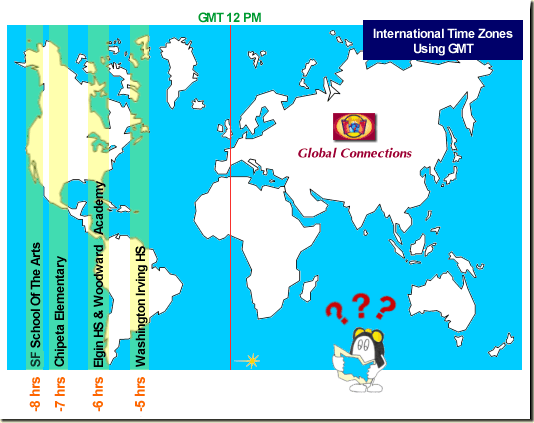
 |
 |
The Global
Connections project involves schools in 5 different time zones with 5 to 8 hour
time differences between partner schools. Below is a map representing the
international time zones for the 5 schools in the USA compared with those in the
UK at GMT (Greenwich Mean Time).
 |
With some electronic media, time differences can almost be an advantage at times. For example, electronic mail messages sent late from the UK could be picked up during the day in the US, so replies were available at the start of the next UK school day. With videoconferencing, all parties have to be available simultaneously. When the project started, we didn't know how the time differences would affect the planning of videoconferencing sessions, or the sessions themselves. In the main, we found that time differences of less than a school day were unimportant at secondary level, although our middle schools noted that whereas the US partner could have immediate follow up, the UK partner, working at the end of the school day, had to wait until the following day! With 7 and 8 hour time differences, at least one group had to work outside normal school hours, which was less convenient and required more organisation (letters to parents, checking transport arrangements, etc.). |
 |
6 hours time gap isn't a real problem. Stuart MacDonald, Sgoil Lionacleit |
 |
 |
5 hours is less important than the 25 minutes overlap on school timetables. Colin Bunyan, Boston Spa comprehensive |
 |
 |
Having videoconferencing sessions outside school time is a big drawback. Chris Carlson, Chipeta Elementary School |
 |
 |
Tip:
When planning videoconferencing projects across different time zones, you should
make sure you know exactly when the clock changes in different parts of the
world! There may be odd weeks in Spring and Autumn when the time zone
difference is one hour greater or one hour less. |
 Produced by Melchior Telematics for BT
Community Partnerships © 1998-9
Produced by Melchior Telematics for BT
Community Partnerships © 1998-9